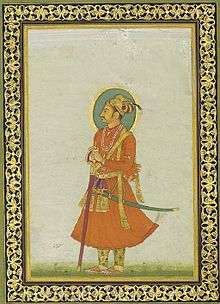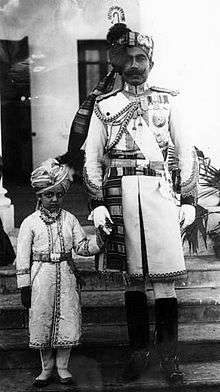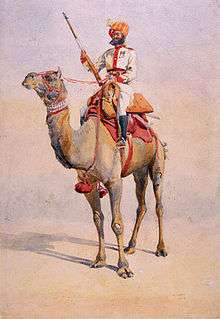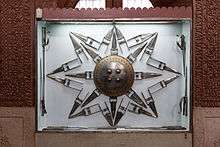Bikaner State
| Bikaner State बीकानेर रियासत | ||||||
| Princely State of British India | ||||||
| ||||||
| ||||||
 | ||||||
| History | ||||||
| • | Established | 1465 | ||||
| • | Independence of India | 1947 | ||||
| Area | ||||||
| • | 1931 | 60,391 km2 (23,317 sq mi) | ||||
| Population | ||||||
| • | 1931 | 936,218 | ||||
| Density | 15.5 /km2 (40.2 /sq mi) | |||||
| Today part of | Rajasthan, India | |||||

_(8441306001).jpg)




Bikaner State was a princely state in the Bikaner region from 1465 to 1947. Its capital was the city of Bikaner in the northern area of present-day Rajasthan State in India.
Covering an area of 60,391 km2 (23,317 sq mi), Bikaner State was one of the largest states under the Rajputana Agency. Heeding the call of Vallabhbhai Patel to integrate the princely states into the new independent India, Bikaner's last king, Maharaja Sadul Singh, advised by his dewan K. M. Panikkar, a respected historian, was one of the first rulers of a princely state to display willingness to join the Indian Union. By issuing a public appeal in April 1947 to his fellow princes to join the Constituent Assembly of India, the Maharaja of Bikaner set an example for other heads of the native states to follow.[1]
History
The state of Bikaner was founded in 1465. It became a British protectorate on 9 March 1818. Its rulers were Rajputs belonging to the Rathore dynasty. They were accorded a 17 gun salute by the British authorities.[2] By the time of Indian Independence, the territory of the state of Bikaner shared a border with Pakistan. The accession to the Indian Union was signed by the Maharaja on 7 August 1947.[3]
Maharajas
- 19 Jun 1698 – 15 Dec 1700 Sarup Singh (b. 1689 - d. 1700)
- 15 Dec 1700 – 16 Dec 1735 Sujan Singh (b. 1690 - d. 1735)
- 16 Dec 1735 – 15 May 1746 Zorawar Singh (b. 1713 - d. 1746)
- 15 May 1746 – 25 Mar 1787 Gaj Singh (b. 1723 - d. 1787)
- 25 Mar 1787 – 25 Apr 1787 Raj Singh II (b. 1744 - d. 1787)
- 25 Apr 1787 - 9 Oct 1787 Pratap Singh (b. 1781 - d. 1787)
- 25 Apr 1787 – 25 Mar 1828 Surat Singh (Regent to 9 Oct 1787) (b. 1766 - d. 1828)
- 25 Mar 1828 - 7 Aug 1851 Ratan Singh (b. 1790 - d. 1851)
- 7 Aug 1851 – 16 May 1872 Sardar Singh (b. 1818 - d. 1872)
- 16 May 1872 – 19 Aug 1887 Dungar Singh (b. 1854 - d. 1887)
- 19 Aug 1887 - 2 Feb 1943 Ganga Singh (b. 1880 - d. 1943) (from 24 Jul 1901, Sir Ganga Singh)
- 19 Aug 1887 – 16 Dec 1898 the British Political Agents -Regent
- 2 Feb 1943 – 15 Aug 1947 Sadul Singh (b. 1902 - d. 1950) (from 1 Jan 1946, Sir Sadul Singh)
- Maharaj Karni Singh
- Maharaj Narendra Singh
- Maharaj Ravi Raj Singh -Present
Dewans
The Dewans and Chief Ministers of the state were:
- 17.. - 26 Feb 1733 Anand Ram Khawas (d. 1733)
- 1735 - Feb 1751 Mohta Bakhtawar Singh (1st time) (b. 1707 - d. 1779)
- Feb 1751 - 1752 Amar Singh Chaturbhujani
- 1752 - 1756 Mohta Bakhtawar Singh (2nd time) (s.a.)
- 1756 - Dec 1757 Mohta Prithvi Singh
- 1757 - 1762 Mohta Bakhtawar Singh (3rd time) (s.a.)
- 1762 - Sep 1765 Shah Mool Chand Bardiya
- Sep 1765 - 1779 Mohta Bakhtawar Singh (4th time) (s.a.)
- 1779 - 178. Mohta Swaroop Singh
- 178. - 1787 Mohta Thakursi
- 1787 - 1791 Mohta Madho Rai
- 1791 - 1794 Pratap Mal Baid
- 1794 - 1805 Mohta Rao Sahib Singh Gun Roop
- Apr 1805 - Apr 1815 Amar Chand Surana
- Apr 1815 - Feb 1816 Mohta Bhomji
- Feb 1816 - 1828 Abhai Singh Mohta
- 1828 - 184. Hindu Mal Baid
- c.1841 Sri Narayan Singh Bhati
- 1844 - 1852? Sarana Shri Lakshmichand
- 1852 - 1853 Guman Singh Baid (1st time)
- 1853 - 1853 Leeladhar Mohta + Jalam Chand Kochar
- 1853 - 1854 Lachhi Ram Rakhecha
- 1854 - 1856 Guman Singh Baid (2nd time)
- 1856 Pandit Dojainant
- 1856 - 1863 Ram Lal Dwarkani (1st time)
- 1864 - 1865 Guman Singh Baid (3rd time)
- 1865 - 1866 Ram Lal Dwarkani (2nd time)
- 1866 Man Mal Rakhecha
- 1866 (3 months) Sheo Lal Nahata
- 1867 (15 days) Fateh Chand Surana
- 1867 Ganga Ram Purohit
- 1867 Shah Mal Kochar
- 1868 Man Mal Rakhecha
- 1868 Sheo Lal Mohta
- 1868 Lakshmi Chand Nahata
- Jun 1868 - Aug 1869 Visayat Hussain
- Aug 1869 - 13 Dec 1873 Pandit Manphool
- Dec 1873 - 188. Maharaj Lal Singh
- 188. - 1884? Maharao Hira Singh Baid
- 1884 - 11 Oct 1888 Amin Muhammad
- 12 Dec 1888 - 1896 Sodhi Hukam Singh
- 1896 - 1898 Raghubar Singh Chauhan
- 1898 - 1903 Hamidu Zafar Khan
- 1903 - 1916 -Post abolished-
Chief ministers
- 1916 - 19.. Shri Bhairon Singh
- 7 Sep 1920 - Jan 1925 Prince Kunwar Sardul Singh (s.a.)
Dewans
The post of Dewan was reinstated in 1927.
- 1927 - 1934 Manubhai Nandshankar Mehta (b. 1868 - d. 1946)
- 3 Oct 1932 – 31 Oct 1934 Ram Prasad Dube (acting)
- 1 Nov 1934 - Jan 1936 Maharaj Shri Bhairun Singh
- Jan 1936 - Dec 1936 Thakur Sadul Singh
- Dec 1936 - 1938? V.N. Mehta
- Dec 1938 - Jul 1939 Kailash Narain Haksar (b. 1878 - d. 1954)
- Jul 1939 - 1944? Sire Mal Bapna (b. 1882 - d. 1964)
- 1944 - 13 Mar 1948 Kavalam Madhava Panikkar (b. 1895 - d. 1963)
- 14 Mar 1948 - Oct 1948 Kanwar Jaswant Singh
- Oct 1948 - 30 Mar 1949 Cadambi Sheshachar Venkatachar (b. 1899 - d. 1999)
Family tree of the rulers of Bikaner
 I. Rao Bikaji, of Bikaner (1438-1504; Rai: 1488; r. 1465-1504)
I. Rao Bikaji, of Bikaner (1438-1504; Rai: 1488; r. 1465-1504)
 II.Rao Naroji, of Bikaner (1468-1505; r. 1504-1505)
II.Rao Naroji, of Bikaner (1468-1505; r. 1504-1505)-
 III.Rao Lunkaraji, of Bikaner (1470-1526; r. 1505-1526)
III.Rao Lunkaraji, of Bikaner (1470-1526; r. 1505-1526)
-
 IV. Rao Jetaji,of Bikaner (1489-1542; r. 1526-1542)
IV. Rao Jetaji,of Bikaner (1489-1542; r. 1526-1542)
-
 V.Rao Kalyan Mal, of Bikaner (1519-1574; r. 1542-1574)
V.Rao Kalyan Mal, of Bikaner (1519-1574; r. 1542-1574)
-
 VI. Raj Singh I, Rao of Bikaner (1541-1612; r. 1574-1612)
VI. Raj Singh I, Rao of Bikaner (1541-1612; r. 1574-1612)
 VII. Dalpat Singh, Rai of Bikaner (1565-1613; r. 1612-1613)
VII. Dalpat Singh, Rai of Bikaner (1565-1613; r. 1612-1613)-
 VIII. Surat Singh, Rao of Bikaner (1594-1631; r. 1613-1631)
VIII. Surat Singh, Rao of Bikaner (1594-1631; r. 1613-1631)
-
 IX. Karan Singh,Rao of Bikaner (1616-1669; r. 1631-1667)
IX. Karan Singh,Rao of Bikaner (1616-1669; r. 1631-1667)
-
 X. Anup Singh, Maharaja of Bikaner (1638-1698; r. 1667-1698; Rao: 1667; Maharaja: 1675)
X. Anup Singh, Maharaja of Bikaner (1638-1698; r. 1667-1698; Rao: 1667; Maharaja: 1675)
 XI. Sarup Singh, Maharaja of Bikaner (1689-1700; r. 1698-1700)
XI. Sarup Singh, Maharaja of Bikaner (1689-1700; r. 1698-1700) XII. Sujjan Singh, Maharaja of Bikaner (1690-1735; r. 1700-1735)
XII. Sujjan Singh, Maharaja of Bikaner (1690-1735; r. 1700-1735)
-
 XIII. Zorawar Singh, Maharaja of Bikaner (1713-1746; r. 1735-1746)
XIII. Zorawar Singh, Maharaja of Bikaner (1713-1746; r. 1735-1746)
-
- Anand Singh
-
 XIV. Gaj Singh, Maharaja of Bikaner (1723-1787; r. 1746-1787)
XIV. Gaj Singh, Maharaja of Bikaner (1723-1787; r. 1746-1787)
 XV. Raj Singh II, Maharaja of Bikaner (1744-1787; r. 1787)
XV. Raj Singh II, Maharaja of Bikaner (1744-1787; r. 1787)
-
 XVI. Pratap Singh, Maharaja of Bikaner (1781-1787; r. 1787)
XVI. Pratap Singh, Maharaja of Bikaner (1781-1787; r. 1787)
-
- Chhatar Singh (1762-1779)
- Dalel Singh
- Sagat Singh
- Lall Singh (1831-1887)
 XX. Dungar Singh, Maharaja of Bikaner (1854-1887; r. 1872-1887)
XX. Dungar Singh, Maharaja of Bikaner (1854-1887; r. 1872-1887)-
 XXI. Ganga Singh, Maharaja of Bikaner GCSI, GCIE, GCVO, GBE, KCB (1880-1943; r. 1887-1943)
XXI. Ganga Singh, Maharaja of Bikaner GCSI, GCIE, GCVO, GBE, KCB (1880-1943; r. 1887-1943)
-
 XXII. Sadul Singh, Maharaja of Bikaner GCSI, GCIE, CVO (1902-1950; r. 1943-1949; titular ruler: 1949-1950)
XXII. Sadul Singh, Maharaja of Bikaner GCSI, GCIE, CVO (1902-1950; r. 1943-1949; titular ruler: 1949-1950)
- XXIII. Karni Singh, Maharaja of Bikaner (1924-1988; titular Maharaja: 1950-1971; family head: 1971-1988)
- XXIV. Narendra Singh, Maharaja of Bikaner (1946-2003; family head: 1988-2003)
- Amar Singh (b. 1925)
- Chandra Shekhar Singh (b. 1948)
- XXV. Ravi Raj Singh, Maharaja of Bikaner (b. 1977; family head: 2003 - )
- Chandra Shekhar Singh (b. 1948)
- XXIII. Karni Singh, Maharaja of Bikaner (1924-1988; titular Maharaja: 1950-1971; family head: 1971-1988)
-
- Lall Singh (1831-1887)
- Madan Singh
- Sagat Singh
- Dalel Singh
-
 XVII. Surat Singh, Maharaja of Bikaner (1765-1828; r. 1787-1828)
XVII. Surat Singh, Maharaja of Bikaner (1765-1828; r. 1787-1828)
-
 XVIII. Ratan Singh, Maharaja of Bikaner (1790-1851; r. 1828-1851)
XVIII. Ratan Singh, Maharaja of Bikaner (1790-1851; r. 1828-1851)
-
 XIX. Sardar Singh, Maharaja of Bikaner (1818-1872; r. 1851-1872)
XIX. Sardar Singh, Maharaja of Bikaner (1818-1872; r. 1851-1872)
-
-
-
-
-
-
-
-
See also
References
- ↑ Ramachandra Guha, India after Gandhi: The History of the World's Largest Democracy. HarperCollins, 2007
- ↑ Rajput Provinces of India - Bikaner (Princely State)
- ↑ William Barton, The princes of India. Delhi 1983
- ↑ Bikaner - family genealogy
![]() This article incorporates text from a publication now in the public domain: Chisholm, Hugh, ed. (1911). "Bikanir". Encyclopædia Britannica (11th ed.). Cambridge University Press.
This article incorporates text from a publication now in the public domain: Chisholm, Hugh, ed. (1911). "Bikanir". Encyclopædia Britannica (11th ed.). Cambridge University Press.
External links
 Media related to Bikaner State at Wikimedia Commons
Media related to Bikaner State at Wikimedia Commons- Beny, Roland; Matheson, Sylvia A. (1984). Rajasthan - Land of Kings. London: Frederick Muller. p. 200 pages. ISBN 0-584-95061-6.
- Crump, Vivien; Toh, Irene (1996). Rajasthan (hardback). London: Everyman Guides. p. 400 pages. ISBN 1-85715-887-3.
- Martinelli, Antonio; Michell, George (2005). The Palaces of Rajasthan. London: Frances Lincoln. p. 271 pages. ISBN 978-0-7112-2505-3.
- Tod, James. Annals and Antiquities of Rajasthan, Volume II (With a Preface by Douglas Sladen). Oriental Books Reprint Corporation. 54, Jhansi Road, New Delhi-1100055.
Coordinates: 28°01′N 73°18′E / 28.01°N 73.3°E

